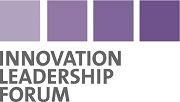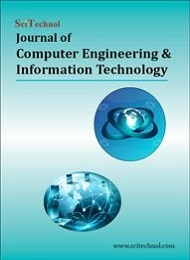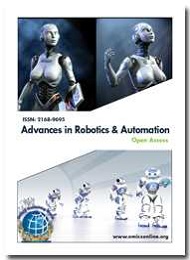Theme: Harnessing the power of Artificial Intelligence
Neural Networks 2018
- About Artificial Intelligence and Neural Networks Conference
- Sessions/Tracks
- Market Analysis
- Past Conference Report
- Researchers
- Scientists
- Professors
- Engineers
- Students
- Smart Innovators
- Robotic Technologist
- Gaming Professionals
- Automation Industry Leaders
- Health Care Service Providers
- Defence Research Professionals
- Managers & Business Intelligence Experts
- Advertising and Promotion Agency Executives
- Professionals in Media Sector
Track 1: Artificial Intelligence
Track 2: Cognitive Computing
Cognitive Computing refers to the hardware and/or software that helps to improve human decision-making and mimics the functioning of the human brain. It refers to systems that can learn at scale, reason with purpose and interact with humans naturally. It comprises of software libraries and machine learning algorithms for extracting information and knowledge from unstructured data sources. The main motive is to accurate models of how the human brain/mind senses, reasons, and responds to stimulus. High-performance computing infrastructure is powered by processors like multicore CPUs, GPUs, TPUs, and neuromorphic chips. They interact easily with users, mobile computing, and cloud computing services so that those users can define their needs comfortably.
Neural Informatics for Cognitive Computing
Neural Information theory is a multidisciplinary enquiry of the physiological and biological representation of knowledge and information in the brain at the neuron level.
Track 3: Self-Organizing Neural Networks
Pattern recognition is a part of machine learning that focuses on the recognition of patterns and regularities in data by using supervised learning algorithms that create classifiers based on training data from different object classes. Optical character recognition (OCR) faces detection, face recognition, object detection, and object classification uses supervised pattern recognition. And the unsupervised learning works by finding hidden structures in clustering techniques.
Feature selection or variable selection is the process of selecting a subset of relevant features for use in model construction. They are also used to simplify the models to make them easier to interpret, shorter training times and enhanced generalization by reducing overfitting (reduction of variables). The data contains many features that are either redundant or irrelevant and can be removed without incurring much loss of information.
Track 4: Backpropagation
Artificial neural networks uses backpropagation method to calculate the error contribution of each neuron after a batch of data (in image recognition) is processed. It is a special case of an older and more general technique called automatic differentiation. It is commonly used by the gradient descent optimization algorithm to adjust the weight of neurons by calculating the gradient of the loss function. This technique is also sometimes called backward propagation of errors because the error is calculated at the output and distributed back through the neural network layers.
Track 5: Computational Creativity
Machine learning is the field of computer science which teaches machines to detect different patterns and to adapt to new circumstances. Machine Learning can be both experienced and explanation-based learning. In the field of robotics machine learning plays a vital role, it helps in taking an optimized decision for the machine which eventually increases the efficiency of the machine and more organized way of performing a particular task. It is employed in a range of computing tasks where designing and programming with good performance is difficult or infeasible for example email filtering, network detection or malicious insiders working towards a data breach optical character recognition (OCR) and computer vision.
Data mining is an extraction process of useful patterns and information from huge data. It is also called as knowledge discovery process, knowledge mining from data, knowledge extraction or data /pattern analysis. It is a logical process that is used to search through a large amount of data in order to find useful data. The goal of this technique is to find patterns that were previously unknown.
Track 6: Artificial Neural Networks
Artificial Neural Networks are the simulations which perform specific tasks like pattern recognition, clustering etc. on the computer.
Artificial neural networks are mathematical models inspired by the organization and functioning of biological neurons. They are similar to the human brains, acquire knowledge through learning and their knowledge is stored within interneuron connections strengths known as synaptic weights.
Architecture of ANN
A large number of artificial neurons called units arranged in a series of layers are contained by neural networks. Different layers are Input layer, Output layer, and Hidden layer.
-
Input layer contains those units which receive input from outside world on which network will learn and recognize the process.
-
Output layer contains units that respond to the information about how it’s learned any task.
-
Hidden layers are in between input and output layers. It transforms the input into something that output unit can use in some ways.
Track 7: Deep Learning
Deep learning is also known as deep structured learning is a part of machine learning process based on learning data representation. It uses some form of gradient descent for training via backpropagation.
The layers used in deep learning include hidden layers of artificial neural networks and sets of propositional formulas.
Deep Neural Networks
DNN is an ANN with multiple hidden layers between the input and output layers. DNN architectures generate compositional models where the object is expressed as a layered composition of primitive. They are typically fed forward neural networks in which data flows from the input layer to the output layer without looping back.
Applications
- Automatic speech recognition
- Image recognition
- Visual art processing
- Natural language processing
Track 8: Ambient Intelligence
Ambient intelligence (AmI) deals with the computing devices, where physical environments interact intelligently and conservatively with people. These environments should be aware of people's needs, customizing requirements and forecasting behaviors. It can be diverse, such as homes, meeting rooms, offices, hospitals, schools, control centers, vehicles, etc. Artificial Intelligence research aims to include more intelligence in AmI environments, allowing better support for humans and access to the essential knowledge for making better decisions when interacting with these environments.
Track 9: Perceptrons
Perceptron is a machine learning algorithm that helps to provide classified outcomes for computing. It is a kind of a single-layer artificial network with only one neuron and a classification algorithm that makes its predictions based on a linear predictor function combining a set of weights with the feature vector.
Multilayer Perceptron
Multilayer Perceptron is a class of feedforward artificial neural networks. And the layered feedforward networks are trained by using the static back-propagation training algorithm. For designing and training an MLP perceptron several issues are involved:
-
A number of hidden layers are selected to use in the neural network.
-
A solution that avoids local minima is globally searched.
-
Neural networks are validated to test for overfitting.
-
Converging to an optimal solution in a reasonable period of time.
Track 10: Cloud Computing
Cloud computing is a branch of information technology which grants universal access to shared pools of virtualized computer resources. A cloud can host different workloads, allows workloads to be scaled/deployed-out on-demand by rapid provisioning of physical or virtual machines, self-recovering, supports redundant, and highly-scalable programming models and allows workloads to recover from hardware/software rebalance and failures allocations.
Artificial Intelligence technology plays a very important role in Making resources available, Distribution transparency and Openness Scalability especially for Cloud Computing Application. Artificial intelligence and cloud computing will have an important impact on the development of information technology by mutually collaborating.
Track 11: Autonomous Robots
Autonomous robots are the intelligently capable machines which can perform the task under the control of a computer program. They are independent of any human controller and can act on their own. The basic idea is to program the robot to respond a certain way to outside stimuli. The combined study of neuroscience, robotics, and artificial intelligence is called neurorobotics.
Application and their classification-
· The autonomous robots are classified into four types
-
Programmable: Swarm Robotics, mobile robots, industrial controlling and spacecraft.
-
Non- Programmable: Path guiders and medical products carriers.
-
Intelligent: Robotics in Medical military applications and home appliance control systems.
-
Adaptive: Robotic gripper, spraying and welding systems.
Track 12: Support Vector Machines
Support Vector Machines are the set of related supervised machine learning algorithm capable of delivering higher performance in terms of classification and regression accuracy. In this algorithm, each data item is plotted as a point in n-dimensional space (where n is the number of features you have) with the value of each feature being the value of a particular coordinate. SVM utilizes an optimum linear separating hyperplane to separate two data sets in a feature space. This optimum hyperplane is produced by maximizing minimum margin between the two sets. Therefore the resulting hyperplane will only be depended on border training patterns called support vectors.
Track 13: Parallel Processing
Parallel Processing reduces processing time by simultaneously breaking up and running program tasks on multiple microprocessors. There are more engines (CPUs) running, which makes the program run faster. It is particularly useful when running programs that perform complex computations, and it provides a viable option to the quest for cheaper computing alternatives. Supercomputers commonly have hundreds of thousands of microprocessors for this purpose. Parallel programming is an evolution of serial computing where the jobs are broken into discrete parts that can be executed concurrently. It is further broken down into a series of instructions and the instructions from each part execute simultaneously on different CPUs.
Track 14: Bioinformatics
Bioinformatics is a multidisciplinary research field that combines computer science, biology, science, statistics and mathematics into a broad-based field that will have profound impacts on all fields of biology. It is the application of computer technology to the management of biological information.
Biocomputing is the computing which designs and constructs the computer containing biological components.
Relation to Artificial Intelligence
Artificial Intelligence has continuously gained attention in bioinformatics
- AI algorithms to be used for keeping records.
- Helping Interpret Large amount of data by using computer technology.
- Choosing a particular method for analyzing data.
Track 15: Ubiquitous Computing
Ubiquitous computing is a branch of computing in computer science and software engineering where computing is made easier so that they can appear anytime and everywhere. It can occur using any device, in any location, and in any format.
Key features include:
-
Use of Inexpensive processors which reduces the storage and memory requirements.
-
Totally connected and constantly available computing devices and capturing of real-time attributes.
-
Focus on many-to-many relationships, instead of one-to-one, many-to-one or one-to-many in the environment, along with the idea of technology, which is constantly present.
-
Relies on wireless technology, converging Internet and advanced electronics.
Track 16: Natural Language Processing
Natural language processing (NLP) is a subset of Artificial Intelligence. Its ability is to interpret and understand human language the way it’s spoken or written and to make the machines/computer as intelligent as human beings in understanding language.
Natural language generation (NLG) and Natural language understanding (NLU) are the two main components of NLP. NLU understanding involves mapping the given input in natural language into useful representations and NLG is the process of producing meaningful phrases and sentences in the form of language.
Track 17: Entrepreneurs Investment Meet
Neural Networks 2018 facilitates a unique platform for transforming potential ideas and research into great business. The meeting aims to gather the researchers, academicians and scientists from the field of Neural Networks and Artificial Intelligence community to create an approach towards a global exchange of information on technological advances, new scientific innovations, and the effectiveness of various regulatory programs towards Artificial Intelligence. It's allied sciences to develop and facilitate the most optimized and viable business for engaging people into constructive discussions, evaluation, and execution of promising business.
Related Conferences
-
6th International Conferences on Big Data, Knowledge Discovery and Data Mining, August 06-07, 2018 Abu Dhabi, UAE;
-
World Congress on Computer Science, Machine Learning and Big Data Analytics, August 30-31, 2018 Dubai, UAE;
-
6th World Convention on Robots and Deep Learning, September 10-11, 2018 Singapore City, Singapore;
-
World Machine Learning and Deep Learning Congress, August 30-31, 2018 Dubai, UAE;
-
International Summit on Telecommunication, Cloud Computing and Wireless Technology, August 22-23, 2018 Singapore City, Singapore;
-
Big Data Innovation, Data Mining and Analytics Summit, August 20-21, 2018 Singapore;
-
International Conferences on Mechatronics, Automation and Control Systems, September 17-18, 2018, Berlin, Germany.
-
International Conferences on Artificial Intelligence, Robotics & IoT, August 21-22, 2018 Paris, France;
-
6th International Conferences on Big Data Analytics & Data Mining, September 26-27, 2018 Chicago, USA;
-
7th International Conferences on Artificial Neural Networks, October 05-07, 2018 Rhodes, Greece;
-
International Conferences on Artificial Intelligence and Cognitive Science March 27-18, 2018 Tokyo, Japan;
-
2nd International Conferences on Cognitive Computing, June 30, 2018, Seattle, USA;
-
Applied AI Summit, July 9-11, 2018 London United Kingdom;
-
International Symposium on Information Processing in Sensor Networks, Apr 11-13, 2018 Porto, Portugal.
-
23rd European Conferences on Artificial Intelligence, July 13-19, 2018 Stockholm, Sweden;
-
2018 3rd International Conferences on Pattern Analysis and Intelligent Systems (PAIS), October 24-25, 2018 Tebessa, Algeria;
-
2018 Intelligent Systems Conferences (IntelliSys), September 06-07, 2018, United Kingdom;
-
International Conferences on Artificial Intelligence and Statistics, April 09-11, 2018 Playa Blanca, Spain;
-
First International Conferences on Artificial Intelligence for Industries (AI4I), September 26-28, 2018 Laguna Hills, CA, USA;
-
SIAM International Conferences on Data Mining, May 03-05, 2018 United States;
-
2018 2nd International Conferences on Recent Advances in Signal Processing, Telecommunications & Computing (SigTelCom), January 29-31, 2018 Ho Chi Minh City, Vietnam;
-
6th International Conferences on Brain and Computer Interface (BCI), January 15-17, 2018 Gangwon-Province, Korea (South);
-
International Conferences on Data Analysis and Cloud Computing, September 06-07,2018 London, United Kingdom, France;
-
17th International Conferences on Artificial Intelligence and Soft Computing, Jun 03- 07, 2018 Zakopane, Poland;
-
International Conferences on High Performance Computing in Asia-Pacific Region (HPC Asia), January 29 -31, 2018 Tokyo, Japan;
-
IEEE International Conferences on Advanced Video and Signal-Based Surveillance, November 27-30, 2018 Auckland, New Zealand;
-
IEEE Topical Conferences on Wireless Sensors and Sensor Networks (WiSNet), January 14–17, 2018 CA, USA;
-
IEEE International Conferences on Future IoT Technologies, January 18-19, 2018 Eger, Hungary;
-
19th IEEE/ACIS International Conferences on Software Engineering, Artificial Intelligence, Networking and Parallel/Distributed Computing (SNPD), June 27-29 2018, Busan, Korea (South);
-
International Conferences on Information Networking (ICOIN), January 10-12 2018 Chiangmai, Thailand;
-
EEE International Conferences on Artificial Intelligence and Virtual Reality (AIVR), December 10-12, 2018 Taichung, CA, Taiwan;
-
IEEE Conferences on Computational Intelligence and Games (CIG), August 14-17, 2018 Maastricht, Netherlands;
-
IEEE International Conferences on Systems, Man, and Cybernetics, Oct 7-10, 2018, Miyazaki, Japan;
-
The International Conferences on Automated Planning and Scheduling, June 24- 29, 2018 Delft, Netherlands;
-
2018 IEEE International Work Conferences on Bioinspired Intelligence (IWOBI), July 18 -20, 2018 TBD, Costa Rica;
-
2018 Second IEEE International Conferences on Robotic Computing (IRC), 31Jan-02Feb, 2018 CA, USA;
-
AAAI Conferences on Artificial Intelligence, February 02, 2018 New Orleans, United States;
-
European Conferences on machine Learning and Knowledge Discovery in Databases, September 10-14, 2018 Dublin, Ireland.
Related Societies
Importance and Scope:
Artificial intelligence technology is changing the face of medical science by creating virtual personal healthcare assistant and health bots to give customer support. AI is mostly used in the production unit of manufacturing company where robots are being used give a different shape to an object, which displaces object from one place to another. The conference aims to discover advances in Artificial Intelligence technologies, educational fields, commercial and private sectors. It will facilitate a series of discussions about building knowledge and sharing new ideas amongst the professionals, industrialists, researchers, and students from research area of Artificial Intelligence.
Why Finland?
In recent time Finland has emerged high in the technology sector because of its high educational standards, it has more internet connections per capita than any other country. Finland has shown interest in developing AI sector which will offer cybersecurity cooperation, unmanned aircrafts, satellite cooperation, and maritime safety issues, such as dissemination of situation awareness information.
Finland is known for its scenic beauty of natural aura as it is surrounded by the land of forests, fells, countless lakes and collection of islands, it is one of the most extensive and unspoiled natural environments in Europe. It is also a country of contrasts, the Midnight Sun in the summer, the Polar Night and the Northern Lights in the winter.
Benefits:
With members from around the world focused on sharing new ideas and learning about Artificial Intelligence and Neural Networks, this is the best opportunity to reach the largest assemblage of participants from the research centers, universities, community, etc. This will conduct demonstrations, distribute information, meet with current and potential researchers and receive name recognition at this 2-day event. World-renowned speakers, the most recent techniques, tactics, and the newest updates in this technical field are hallmarks of this conference. The conference will facilitate a series of discussions about state-of-the-art processes, organizational transitions, analytics, and technology innovation within the industry and academia.
Top Societies and Association around the World
-
Association for the Advancement of Artificial Intelligence
-
Association for Computing Machinery(ACM)
-
Computing Research Association
-
Florida Artificial Intelligence Research Society
-
IEEE Computer Society
-
The IEEE Computational Intelligence Society
-
The International Neural Network Society
-
Singularity Institute of Artificial Intelligence
-
The Society for the Study of Artificial Intelligence and Simulation of Behaviour
-
British Computer Society, Specialist Group on Artificial Intelligence
-
The European Coordinating Committee on AI (ECCAI)
Target Audience
Researchers, Scientists, Professors, Engineers, Students, Smart innovators, Robotic technologist, Defence Research Professionals, Automation industry leaders, Managers & Business Intelligence Experts, Inventors.
Major Artificial Intelligence Universities in USA
-
Carnegie Mellon University (Pittsburgh, PA)
-
Stanford University (Stanford, CA)
-
Massachusetts Institute of Technology “MIT” (Cambridge, MA)
-
The University of California, Berkeley (Berkeley, CA)
-
Harvard University (Cambridge, MA)
-
Yale University (New Haven, CT)
-
Cornell University (Ithaca, NY)
-
University of Maryland (College Park, MD)
-
Columbia University (New York City, NY)
-
University of Texas (Austin, TX)
-
The University of California, Los Angeles (Los Angeles, CA)
-
University of Michigan (Ann Arbor, MI)
-
Georgia Institute of Technology (Atlanta, GA)
Major Artificial Intelligence Universities in Europe
-
West University of Timisoara (WUT)
-
KU Leuven – Belgium
-
Polytechnic University of Catalonia
-
Radboud University
-
University of Amsterdam
-
University of Edinburgh
-
University of Georgia
-
University of Groningen
-
University of Sheffield
-
University of Southampton
Major Artificial Intelligence Universities in Middle East
-
IZMIR University
-
Canadian University Dubai
-
Rafik Hariri University
-
Yasar University
-
TED University
Major Artificial Intelligence Universities in Asia
-
K L University
-
National University of Singapore
-
James Cook University
-
Georgian Technical University
-
The Hong Kong University of Science and Technology
-
KOC University- Istanbul Turkey
Global Artificial Intelligence Market Analysis & Trends
The Artificial Intelligence Market is poised to grow globally at a CAGR of around 44.3% over the next decade to reach approximately $23.4 billion by 2025. This industry report analyzes the global markets for Artificial Intelligence across all the given segments on global as well as regional levels presented in the research scope. It represents market data for 2013, 2014 revenue estimations are presented for 2015 and forecasts from 2016 till 2025.
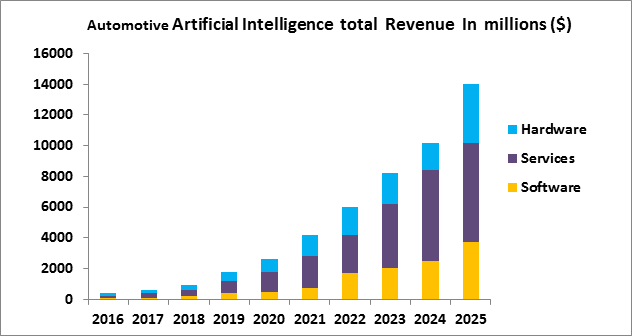
The Artificial Intelligence market in Western Europe education sector to grow at a CAGR of 38.37% during the period 2017-2021, the education system in Europe is gradually adopting e-learning and other related tools such as social learning. The institutions are integrating social media into another platform to facilitate learning, information sharing, and collaboration among students and teachers. These kinds of social networking platform are offered by software solutions such as next-gen LMS.
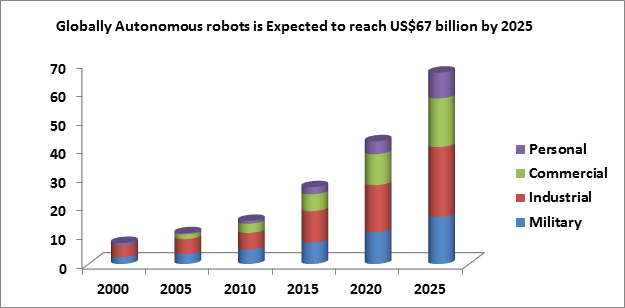
The market of autonomous robots is growing rapidly be it for industrial, military, commercial or consumer applications. In 2005 spending on robotic systems were US $11 billion but by 2025 it is expected to rise to $67 billion. Decades ago industrial robots began transforming manufacturing. With their mechanical, programmable arms, they performed tasks such as painting, welding and placing objects. Today’s autonomous robots are more efficient and time-saving. The BCG estimates that more than $67 billion will be spent globally in the robotics sector by 2025.Companies are investing an enormous amount of time, capital, and manpower to produce software solutions with embedded AI applications and other AI-backed products such as an intelligent tutor. In order to improve AI capabilities of present solutions, extensive research and R&D investments are still being conducted.
Artificialintelligence 2017
Thanks to all of our wonderful speakers, conference attendees, Automation and Robotics-2017 Conference were the best!
The 3rd International Conference on Artificial Intelligence and Robotics, hosted by the ME Conferences were held during June 28-29, 2017 at Hilton San Diego Mission Valley Hotel, San Diego, USA with the theme “Future Trends in the Field of Industrial Automation and Robotics". Benevolent response and active participation were received from the Editorial Board Members of ME Conference Group Journals as well as from the scientists, engineers, researchers, students, and leaders from the fields of Automation and Robotics, who made this event successful.
The meeting was carried out through various sessions, in which the discussions were held on the following major scientific tracks:
- New Approaches in Automation and Robotics
- Machine Learning
- Quest for Artificial Intelligence
- Remote and Telerobotics
- Automation Control
- Prototypical Applications
- Humanoid Robots: New Developments
- Computational creativity
- Affective computing
- Robot Localization and Map Building
- Automation Control
- Robot Manipulators: Trends and Development
New Approaches to Automation and Robotics The conference was initiated with a series of lectures delivered by both Honorable Guests and members of the Keynote forum. The list included:
Ashitey Trebi-Ollennu, NASA Jet Propulsion Laboratory, USA
Lin Zhou, IBM, USA
Timothy Sands, Naval Post Graduate School, USA
Bogdan Gabrys, Bournemouth University, UK
Mikhail Moshkov, King Abdullah University of Science and Technology (KAUST), Saudi Arabia
Jose B. Cruz Jr, National Academy of Science and Technology, Philippines
Fuchiang (Rich) Tsui, University of Pittsburgh School of Medicine, USA
Ryspek Usubamatov, Kyrgyz Technical University, Kyrgyzstan
ME Conferences offers its heartfelt appreciation to the Organizing Committee Members, adepts of the field, various outside experts, company representatives and other eminent personalities who supported the conference by facilitating the discussion forums. ME Conferences also took the privilege to felicitate the Organizing Committee Members and Editorial Board Members who supported this event.
For More details visit: https://neuralnetworks.conferenceseries.com/
Conference Highlights
- Artificial Intelligence
- Cognitive Computing
- Self-Organizing Neural Networks
- Backpropagation
- Computational Creativity
- Artificial Neural Networks
- Deep Learning
- Ambient Intelligence
- Perceptrons
- Cloud Computing
- Autonomous Robots
- Support Vector Machines
- Parallel Processing
- Bioinformatics
- Ubiquitous Computing
- Natural Language Processing
- Entrepreneurs Investment Meet
To share your views and research, please click here to register for the Conference.
To Collaborate Scientific Professionals around the World
| Conference Date | October 15-16, 2018 | ||
| Sponsors & Exhibitors |
|
||
| Speaker Opportunity Closed | Day 1 | Day 2 | |
| Poster Opportunity Closed | Click Here to View | ||
Useful Links
Special Issues
All accepted abstracts will be published in respective Our International Journals.
- Advances in Robotics & Automation
- Journal of Computer Science & Systems Biology
- Journal of Data Mining in Genomics & Proteomics
Abstracts will be provided with Digital Object Identifier by
























